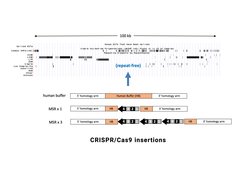De novo heterochromatin formation by DNA repeat sequences
Lab Jenuwein
Heterochromatin is nearly always nucleated by underlying DNA repeat elements. Although around half of the mammalian genome consists of repetitive elements, less than 10% of those retain transcriptional activity. Only transcriptionally competent long intergenic nuclear elements (LINE) and endogenous retroviruses (ERV) and the major satellite repeat (MSR) sequences are decorated with Suv39h-dependent H3K9me3 (Bulut-Karslioglu et al. 2014). Major satellite repeats (MSR) and intact LINE elements are the primary chromatin regions to be silenced by the Suv39h enzymes in mouse ES cells and permutated or truncated MSR or LINE elements fail to accumulate Suv39h-dependent H3K9me3.

These data allow the dissection of genomic repeat sequences that would direct the de novo formation of heterochromatin. Based on our genome-wide epigenetic profiling, we identified genomic regions in mouse ES cells that lack the main histone modifications, display little or no DNA methylation and have no RNA output. We have started to insert one or three copies of the basic unit (234 bp) of the MSR and of permutated MSR derivatives into these inert regions of the mouse genome by CRISPR/Cas9-mediated integration of DNA sequences (Figure 1). The initial data indicate that 1 intact copy of the MSR is insufficient, but that 3 reiterated and intact MSR copies induce a local enrichment of H3K9me3 over the integration site. These analyses will allow the definition of genomic repeat sequences that can direct the de novo formation of mouse heterochromatin.
